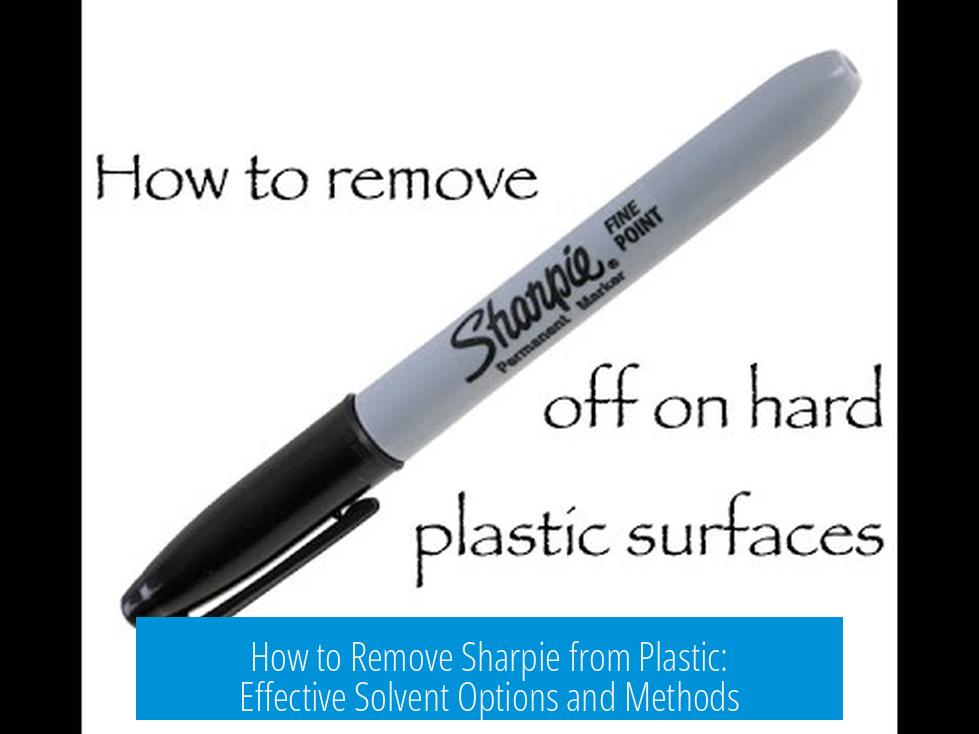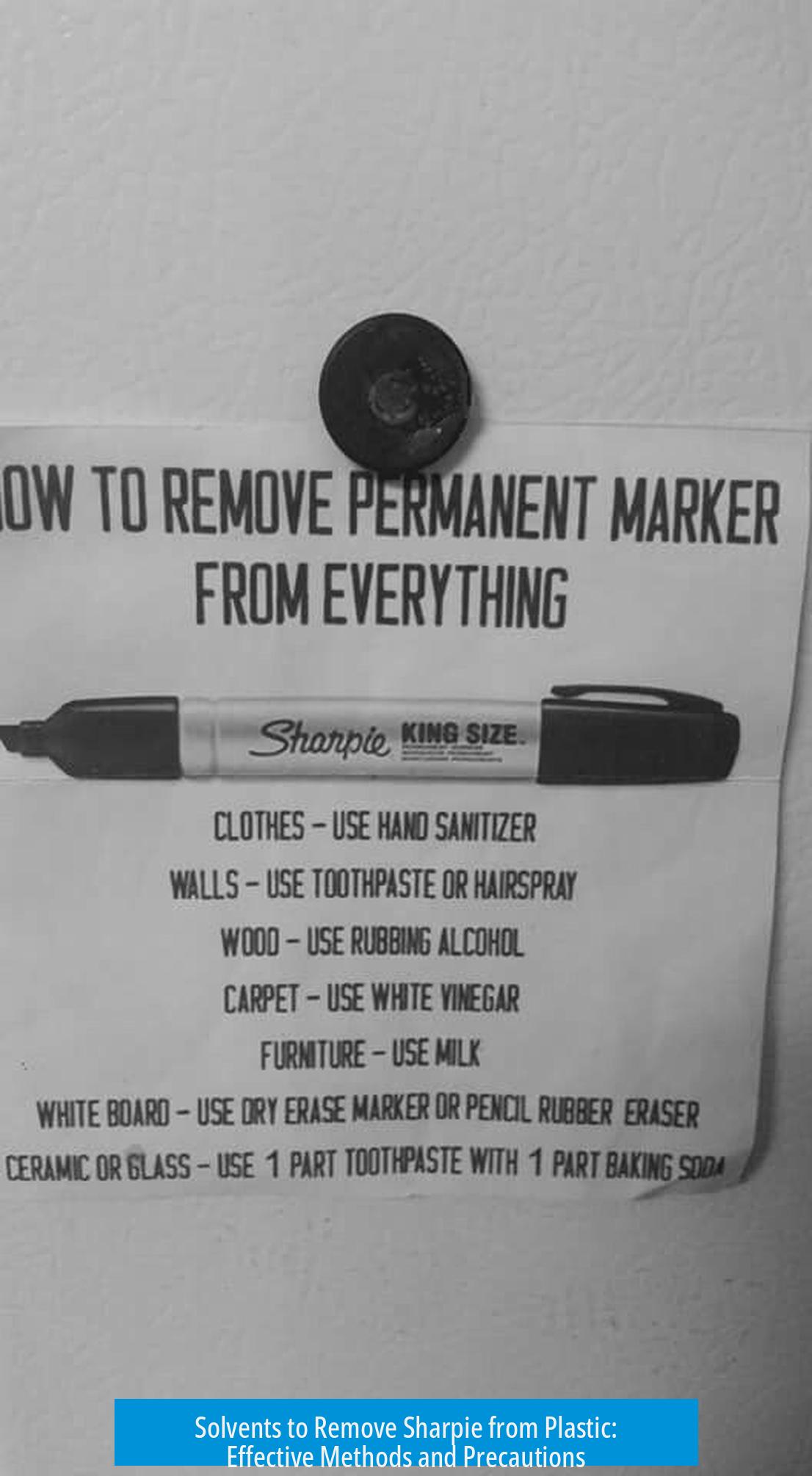How to Remove Sharpie from Plastic: Effective Solvent Options and Methods

Removing sharpie marker from plastic surfaces often requires specific solvents or methods due to the nature of the marker ink interacting with the plastic. When the ink has absorbed into or chemically bonded with the plastic, it becomes especially challenging. Among various attempts, using solvents like acetone or isopropyl alcohol works in many cases, but if these fail, other chemical or mechanical options must be considered.
Understanding the Challenge: Why Sharpie Ink Sticks to Plastic
Sharpie ink is designed to be permanent and fast-drying. Its solvent components dissolve the dye and allow it to penetrate or bond to the plastic’s surface. If acetone or alcohol fails to remove the marker, it usually means that the ink has absorbed into the plastic rather than sitting on top. This absorption makes the removal process difficult without damaging the plastic underneath.
Some plastics absorb ink dyes more readily. In such cases, the marker ink becomes nearly impossible to remove with typical household solvents.
Common Solvents to Try for Sharpie Removal
1. Acetone and Alcohols
- Acetone: A popular choice often effective on many plastics. Use quick wipes only; prolonged exposure may soften or damage plastics like acrylic or plexiglass.
- Isopropyl alcohol (IPA): Widely recommended, especially with concentrations around 70% or higher (up to 90%). It dissolves many ink formulations with less risk to plastic compared to acetone.
- Ethanol and Methanol: These alcohols also can be useful. Methanol is commonly used in lab environments for removing markers on glassware and may work on plastics.
Note that if these solvents do not visibly remove the marker, the ink likely penetrates deeper, reducing chances for easy removal.
2. Ketones and Stronger Organic Solvents
- Methyl ethyl ketone (MEK): A powerful solvent with a slower evaporation rate than acetone; effective in industrial applications for cleaning permanent marker.
- Methyl propyl ketone (MPK): Very strong solvent used in specialized cleaning.
- Toluene, Xylene, Dichloromethane: These solvents can remove ink but carry risks of damaging some types of plastic. Use caution and test first on a small area.
- Tetrahydrofuran (THF) and Acetonitrile: Strong solvents effective in labs but not commonly recommended for general household use due to toxicity and potential plastic damage.
3. Hydrocarbon-Based Solvents and Specialty Cleaners
- WD-40 and Naphtha: Hydrocarbon solvents that can dissolve marker ink on some plastics without aggressive damage.
- Goof Off: Effective but likely to fog or degrade clear plastics.
- 3M General Adhesive Cleaner: Commercial product sometimes helpful.
4. Household Items and Alternative Approaches
- Spray sunscreen or deodorant: Some anecdotal reports suggest mild removal capabilities due to solvents in their formula.
- Vegetable oil: Can help soften residue but unlikely to remove deeply absorbed ink.
- Hydrogen peroxide or bleach: Rarely effective and may cause discoloration or damage to plastic.
Marker-Based Removal Techniques
Dry-Erase Marker Method
Using a dry erase or whiteboard marker to color over the sharpie writing can sometimes lift the ink. The solvent in the dry erase marker reactivates and dissolves the permanent ink, allowing it to be wiped away. This method requires immediate wiping and full coverage.
Reapplying Sharpie Over Old Sharpie
Applying a new layer of permanent marker over the old ink and then wiping it off while wet can help loosen the original stain. The fresh solvent in the new ink dilutes and reactivates the old ink before removal.
Mechanical Removal Options
Sanding and Buffing
When chemical solvents fail, sanding the plastic surface with fine sandpaper or polishing compounds can physically remove the ink layer. This method risks scratching or dulling the plastic, so it is best used on less visible areas or with caution.
Magic Sponges and Abrasive Cleaners
Magic erasers and abrasive toothpaste might help diminish sharpie stains but can also affect plastic gloss and texture.
Precautions and Considerations
- Always test solvent on an inconspicuous area first to check for damage or discoloration.
- Avoid prolonged exposure to strong solvents like acetone, MEK, or dichloromethane, which can melt or haze plastics.
- Use proper ventilation and protective gear when handling strong solvents.
- If plastic surface integrity is critical, mechanical options may be safer than harsh chemicals.
- If the ink has penetrated deeply, consider covering the mark with a permanent fix such as chalkboard paint or decal rather than risking surface damage.
Summary of Effective Approaches for Removing Sharpie from Plastic
| Method | Effectiveness | Caution |
|---|---|---|
| Acetone, Isopropyl Alcohol | Good starting solvents for surface ink | Test first; acetone can damage some plastics |
| Methyl Ethyl Ketone, Toluene, Xylene | Stronger solvents, effective on tough ink | Potential plastic damage; use in ventilation |
| Dry Erase Marker Overlay | Works on fresh or surface ink | Requires immediate cleaning; may not work on absorbed ink |
| Mechanical Sanding/Polishing | Effective for difficult stains | Can scratch or dull plastic finish |
| Hydrocarbon Solvents (WD-40, Naphtha) | Moderate effect, safer on some plastics | Check compatibility; flammable |
Sharpie marks that are deeply absorbed into plastic are difficult to remove without risking damage. A combination of solvent trials and mechanical action often yields the best results. When solvents fail, creative alternatives such as covering the stain may be the safest approach.
Key Takeaways
- Start with acetone or isopropyl alcohol for easy removal.
- Stronger solvents like MEK and toluene remove tough ink but risk plastic damage.
- Dry erase markers can loosen permanent ink on the surface.
- Mechanical abrasion removes ink physically if chemical methods fail.
- Test all solvents on a hidden spot before full application.
- If ink absorbed into plastic, permanent removal is unlikely without damage.
- Consider alternative solutions like painting over the mark if removal fails.
What solvents usually work to remove Sharpie from plastic?
Acetone and isopropyl alcohol often dissolve Sharpie ink from plastic surfaces. Using 70% or higher concentration of isopropyl alcohol can increase effectiveness. Quick wiping is better than scrubbing.
What to do if acetone or alcohol doesn’t remove the Sharpie?
If they fail, the ink may have soaked into the plastic itself, making removal very difficult. Mechanical methods like gentle sanding or buffing might be needed, or covering the mark with paint.
Can dry erase markers help remove Sharpie ink?
Yes. Coloring over Sharpie marks with a dry erase marker can dissolve the permanent ink. Wiping the surface immediately afterward usually removes both inks effectively.
Are there stronger solvents that can remove Sharpie but safe for plastic?
Methyl ethyl ketone or toluene may work but can damage plastic. Use these cautiously. Hydrocarbon-based solvents like WD40 sometimes help but may leave residue or haze the surface.
Is it possible to remove Sharpie that has dyed into the plastic?
When ink penetrates plastic, it bonds internally. Solvents might not remove it without harming plastic. In such cases, repainting or covering the area might be the most practical solution.





Leave a Comment